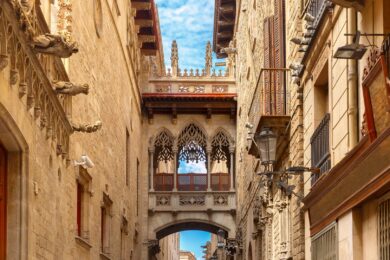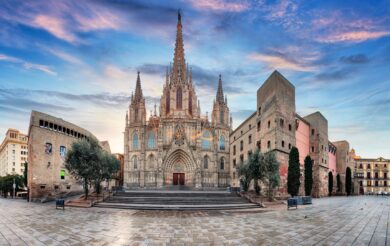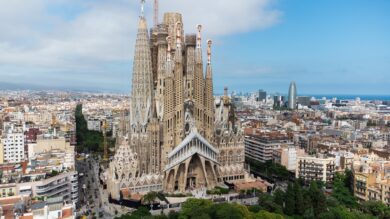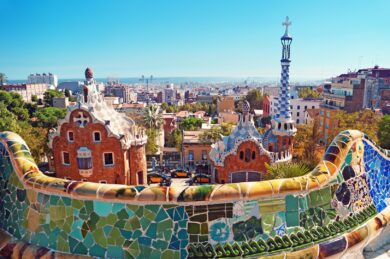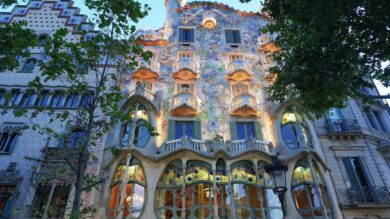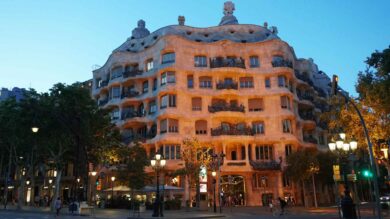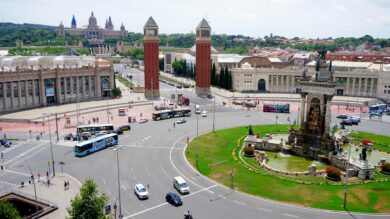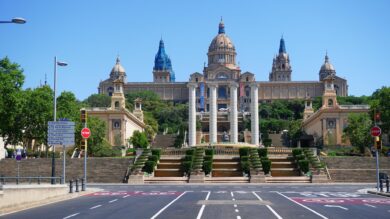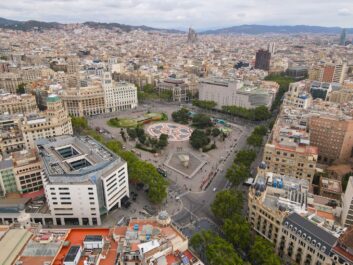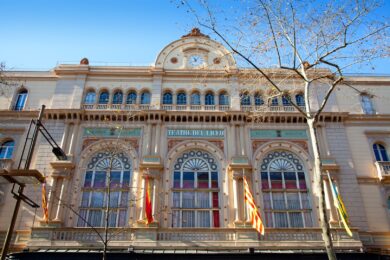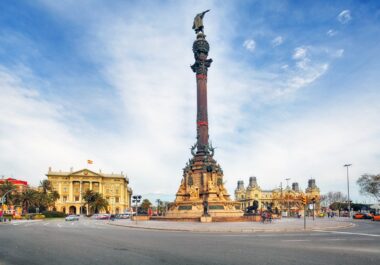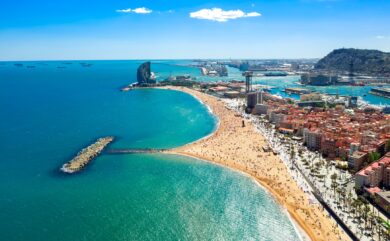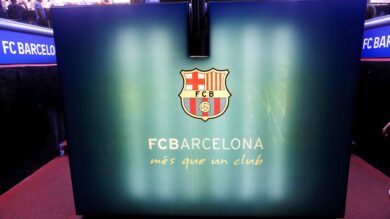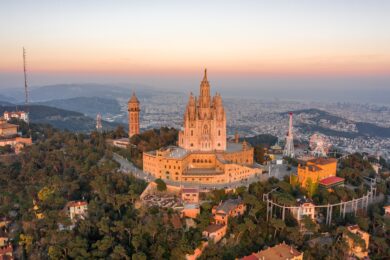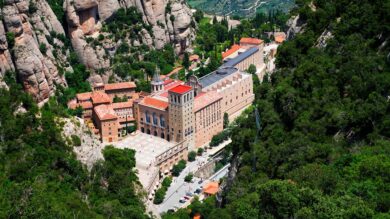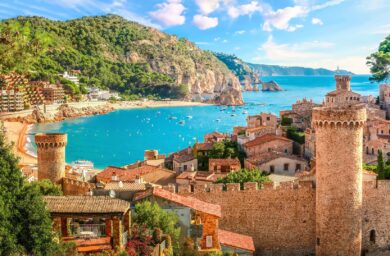Stretching from La Rambla to Via Laietana and from the Mediterranean seafront to the Ronda de Sant Pere, the Gothic Quarter is the heart of Old Barcelona. It has a rich and storied history that dates back nearly 2,000 years. Some of the key sights in the Quarter include the Barcelona Cathedral, Plaça del Rei (King's Square), Plaça Reial (Royal Plaza) and Plaça de Sant Jaume, where City Hall and other government buildings are located.
Located in Barcelona's Gothic Quarter, the Barcelona Cathedral, also known as the Cathedral of the Holy Cross and Saint Eulalia, is famous for the gargoyle sculptures at the top of its towers, the Gothic cloister constructed between the 13th and 14th century, the Choir with a beautiful set of carved wooden chairs, and the rooftop where visitors can see the Cathedral's towers. It is also the seat of the Archbishop of Barcelona.
La Sagrada Familia, a UNESCO World Heritage site and Antoni Gaudi’s magnum opus, is the most iconic and most popular structure in Barcelona. Gaudí started work on it in 1882 and worked on it until his death in 1962. However, he only managed to complete the crypt, the apse walls, a portal, and a tower. Since then, a series of architects have attempted to continue his legacy. The surreal structure is a must-see for every visitor to Barcelona.
Built from 1900 to 1914, Park Güell is a public park located on Carmel Hill, and one of the most famous works by the Catalan modernist architect Antoni Gaudí. The Park reflects Gaudi's naturalist phase when he was inspired by organic shapes. Some of the most famous works in the park include the main entrance, the two pavilions that form the porter's lodge or Casa del Guarda, and the dragon in the center of the staircase, covered with colorful ceramics.
Built between 1904 and 1906 during the Catalan Modernese period, Casa Batlló is a testament to Antoni Gaudí's visionary architectural talent. Designated as a UNESCO World Heritage Site, the building is open to the public, allowing visitors to learn about Gaudí's innovative design and symbolism both on the exterior façade and in the stunning interiors, which feature curved wooden surfaces, stained glass windows, and wrought-iron elements.
Casa Milà, also known as La Pedrera (the Stone Quarry) due to its resemblance to an open quarry, is a modernist building built between 1906-1912 by the architect Antoni Gaudí. It was the last private residence designed by Gaudí. The building is an iconic work due to its many design innovations, ranging from the façade to the wrought ironwork, the open plan that eliminated the need for load bearing walls, the ceilings, and the decorative arts.
Plaça d'Espanya, is one of the most important squares in Barcelona. At the entrance to the square are two impressive Venetian Towers, inspired by the campaniles of St. Mark's Square in Venice. Behind the towers is the Magic Fountain (Font Màgica) of Montjuïc which hosts nightly light and music shows. On the other end of the square is the Las Arenas shopping mall, which has a rooftop terrace with great views of the square and the city.
The Palau Nacional, or National Palace, is a majestic building that combines elements of Neoclassical and Renaissance Revival architecture. Located on Montjuïc Hill, the building offers spectacular panoramic views of the city. It is also home to the Museu Nacional d'Art de Catalunya (MNAC), which has an outstanding collection of Catalan and European Art, including Romanesque, Gothic, Renaissance, Baroque, and Modernist works.
Plaça de Catalunya is the nerve centre of the Catalan capital. Several of the city's most important street and avenues including the Passeig de Gràcia, Rambla de Catalunya, La Rambla, Ronda de Sant Pere, Carrer de Vergara and others meet at this square. It is also where the Old City (Barri Gotic) and the new city meet. The square is surrounded by numerous shops, department stores, boutiques and restaurants.
The Gran Teatre del Liceu, Barcelona's Opera House, opened on April 4, 1847. The five-tier auditorium with 2,292 seats, is considered one of the largest and finest Opera houses in Europe today. Located on La Rambla, it hosts major opera and ballet productions, and symphony concerts every year from September through July. The building was destroyed by fire in 1847 and again in 1994. After a 5 year restoration, the theater re-opened in 1999.
Located at the lower end of La Rambla, the Mirador de Colom was built in 1888 as a monument to Christopher Columbus. At the top of the monument is a statue of Columbus pointing out to sea with his right hand. While it is commonly believed that he is pointing to the New World, the statue actually points south-southeast, rather than West. Inside the column, there is a lift that goes up to a viewing gallery 60 meters or 197 feet above the ground.
La Barceloneta was constructed during the 18th century for the residents of the La Ribera neighborhood, who had lost their homes due to the construction of the Citadel of Barcelona. It is best known for its sandy beach, and the many restaurants and nightclubs along its beach boardwalk. It is also believed to be the inspiration for the setting of the fight between Don Quixote and the Knight of the White Moon, in the famous book by Miguel de Cervantes.
Camp Nou (New Field) is the home stadium of FC Barcelona, commonly known as Barça, which is one of the most famous soccer teams in the world. World famous players like Lionel Messi, Luis Suarez, Neymar, Ronaldinho, Andres Iniesta, and even Diego Maradona once played. With a seating capacity of 99,354 it is the largest stadium in Spain and Europe. The stadium is currently being renovated to increase its capacity to 105,000 and add a roof.
Tibidabo hill is the best place in the city for spectacular views of Barcelona. Standing at 512 meters (1680 ft), this hill is the highest point in Barcelona and a very popular sightseeing spot. At the summit of the hill is the Sagrat Cor Church, and the Tibidabo Amusement Park, which opened in 1905. It is one of the oldest functioning Amusement Parks in the world. Tibidabo can be reached by road or via the Tibidabo Funicular, which was the first of its kind in Spain, and by the Tramvia Blau.
About 50 km northwest of Barcelona, Montserrat mountain (meaning serrated or saw like) offers breathtaking views of the Catalan Pre-Coastal Range of mountains. The 16th century Benedictine Abbey of Santa Maria de Montserrat, which houses the revered statue of the Black Madonna, is located on top of the mountain. The monastery can be reached by cable car from the valley below with the “Aeri de Montserrat.” There is also a funicular which goes up to a higher viewpoint.
Located around two hours north of Barcelona, the Costa Brava, meaning 'wild coast' in Spanish, is one of Europe's most romantic and scenic stretches of coastline along the Mediterranean Sea. Some of the key sights include the medieval town of Tossa de Mar, the ruins of Empúries, the Sant Pere de Rodes Monastery, and the towns of Girona, and Figueres, the birthplace of the renowned Surrealist artist Salvador Dalí. The beaches of Platja de Pals, Platja de Lloret, Platja de Roses, and Cala Montjoi are also not to be missed.
